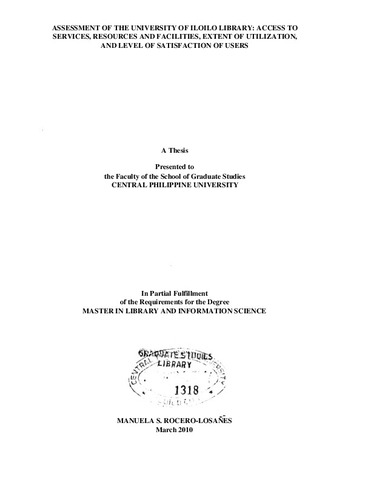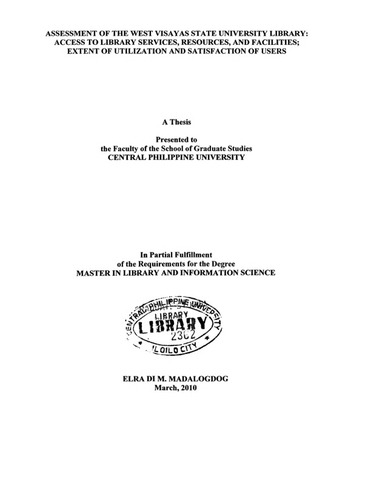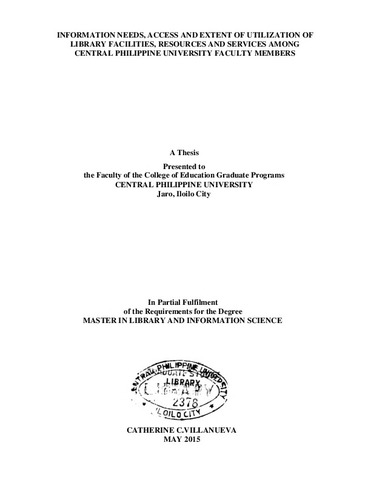Assessment of the University of Iloilo library: Access to services, resources and facilities, extent of utilization, and level of satisfaction of users

Page views
5,593Дата
2010Автор
Thesis Adviser
Defense Panel Chair
Share
Metadata
Показать полную информацию
Аннотации
This study was conducted to determine the assessment of University of IloiloPEN Library users in terms of (a) access to, (b) extent of utilization, and (c) satisfaction with resources, facilities and services. The study further aimed to determine if there are significant differences in the users’ assessment of (a) Access to, (b) Extent of Utilization, and (c) users’ Satisfaction with Services, resources, and facilities at the University Library. In addition, this aimed to determine if there are significant relationships between the users’ (a) Access to, (b) Extent of Utilization, and (c) Level of Satisfaction with Services, resources, and facilities at the University Library.
This descriptive-correlation study utilized a researcher-made survey questionnaire and administered it at the University of Iloilo randomly stratified students and Faculty Members from the different Colleges.
Data obtained were processed and analyzed using the Statistical Package for Social Sciences (SPSS) for XP version 17.0. Frequency distribution, ANOVA test, z-test, Chi square and Gamma tests were used as statistical tools.
Major Findings of the Study
Most of the student respondents were female (n= 256, 68.8 percent) and were dominated by 18 years old and below. Students from the College of Nursing (n=146, 39.2 %) had the most number of respondents, while only almost one-fourth were Criminal Justice students. Majority of them were First Year Students (n= 149, 40.1%).
More than half of the faculty respondents were 20-35 years old (55.5 percent), and a little more than 10 % were 51-65 years old. Most of them were female (57.8%) They were mostly from the College of Nursing, and majority consists of Bachelor’s degree holders.
Most students claimed that they could access the services right at the time when they need it. The mean of 1.88, showed that the University of Iloilo-PEN Library services are accessible. With the mean of 1.80for the Resources in the University of Iloilo Library revealed accessibility.
The majority of faculty members also have access to the library services and resources (m= 2.00 and 1.31).
Almost all respondents, both faculty (100%) and students (99.7%), indicated that they could access (means = 2.00) the Facilities immediately when needed.
With regards to Extent of Utilization, student respondents utilized the library services mostly sometimes (62.9%). The mean 3.28 indicated that they have moderate utilization of the Library Services.
In terms of resources, almost half of the student respondents utilized them sometimes. A very little portion (1.6%) declared that they seldom utilized library resources. As an entire group, their utilization to services was found to be moderate.
When it comes to facilities, only 0.4% of the students utilized the library facilities “always” while only 1.1% indicated that they seldom used the library facilities. Results indicated that the students generally utilized the library facilities “sometimes”.
Faculty members’ utilization of services also indicated that they utilized the library “sometimes” (73.4%). On their utilization of resources, only 5.5% utilized the resources always, but 14.1 percent “seldom” used them. Most of them utilized the resources sometimes (46.0 percent). Low Utilization of resources by the faculty members was noted with the mean of 2.55. With regards to facilities, most faculty members utilized only “sometimes” while the remaining one-fourth “seldom” utilized. The mean 3.21 indicated moderate utilization. As a whole, faculty members’ utilization of services, resources and facilities proved to be only moderate with the 3.21 mean.
Generally, the library users were found to have moderate utilization, as indicated by the grand mean (3).
On the Level of satisfaction, students were found to have high satisfaction with the services. Regarding the resources, almost half of the students were just “fairly satisfied”. The mean of 3.56 percent indicates that they were moderately satisfied with the library resources. In terms of library facilities, the data revealed that students have high satisfaction. In general, students’ (mean 3.61) satisfaction with services, resources and facilities is high.
The faculty members in general are fairly satisfied with the library services. Almost four percent (3.9%) were very satisfied but almost ten percent (9.4%) were dissatisfied. Faculty members’ level of satisfaction with the services is generally Moderate (mean=3.38). In terms of resources, faculty members were mostly fairly satisfied while only 3.9 percent of the faculty members were very dissatisfied with the resources. The 3.38 mean indicates that faculty members’ satisfaction with resources is moderate.
Satisfaction with facilities of faculty members is also moderate as suggested by the mean (3.17). Generally, faculty members have moderate satisfaction with services, resources and facilities as indicated by the mean 3.22.
When differences of access to services, resources and facilities were analyzed, Students’ access to services when grouped according to sex was found to have a significant difference (z-test results -3.509; sig=.001).
With regards to resources, the results (sig=.318) indicated insignificant difference.
When it comes to access to facilities, data showed that sex has no bearing on the access to facilities and equipment, judging from the z-test result (sig=.644).
On Extent of Utilization, insignificant difference between male and female mean scores was found (z=-1.971; p-value= .050). When it comes to resources, results showed significant difference in the means of male and female students.
Results of the analysis of differences on level of satisfaction with services showed a very slight or no variation at all between the level of satisfaction with the services scores of male (3.2640) and female (3.5205) students. Satisfaction with resources indicated no significant difference between the Satisfaction Scores of male (3.5205) and female (3.4013).
Meanwhile, data illustrated that male (3.3841) and female (3.6282) students differed in Satisfaction with the Library’s Collection, Facilities and Services.
On Faculty Members’ access to services among male (1.6580) and female (1.8365) faculty members, z-test result (sig=.000) indicated significant difference. The ztest result (sig=.000) says that there is a significant difference among the access to resources of male (1.5556) and female (1.7551) faculty members.
Another significant difference was found to exist among the access to facilities between male (1.7859) and female (1.8545), as supported by the z-test result (pvalues=.000).
Sex has no significance in the extent of utilization of services of the Library. This is confirmed by the z-test outcome (sig=.618). Consequently, there is a significant difference on extent of utilization of facilities & equipment (male=3.2657; female=9.2753; z-test result (Sig=.806).
The whole data further revealed that there is no significant difference between extent of utilization of services, extent of utilization of resources, extent of utilization to Facilities and equipments of male and female faculty respondents.
With regards to Satisfaction, there is no significant differences among level of satisfaction of services between male (3.2467) and female (3.3600) faculty members, as proven by the z-test Result (sig=.206); Scores of male (3.2359) and female (3.1550) faculty members on Satisfaction Resources, and Facilities, z-test Result (sig=.155) for Facilities and Equipment, and (sig = .696). The hypothesis was confirmed by these findings. This then provides knowledge/awareness that sex is not a controlling factor when it comes to satisfaction.
Regarding the differences of the means of Access to Services, when the Students were grouped according to Age, the Sig =.017 value as the ANOVA test result indicated a difference. This endorsed for the implication that Age has an effect to the Access to Services of the students. This may be because the older people get, the higher are their bases for what would satisfy them.
A deviation in differences, however, was found in the Access to Resources or Collection (Sig. = .422), and Access to facilities and Equipment.
The significance of differences continued in the Utilization of Services, Resources, Facilities and Equipment, until the Satisfaction of the respondents with these services when respondents were grouped by age. This simply showed that Age directly influences the Access to, Utilization of and Satisfaction with the Library Service, Collection, Facilities and Equipment.
A significant difference was also found to exist in the Faculty Members’ Access to Services, Collection, Facilities and Equipment when they were classified according to Age (.000).
Moreover, Age also influences the Faculty Members’ Utilization of Facilities and Equipment, and Satisfaction with the Services in the Library. On the other hand, Age seemed not to have bearing on the Faculty Members’ Utilization of Services and Resources, Satisfaction with Resources, Facilities and Equipment.
Generally, Year level has something to do with the Students’ Access and utilization of the Library services (sig = .034, .000, .023), and Resources, Utilization of Facilities (Sig. =.008, Satisfaction with Services, Resources (Sig. = .001), and Satisfaction with Facilities (sig=.000). Year Level has nothing to do in terms of Utilization of Services, and Resources (sig.= .146 and 0.69).
Variations in Faculty Members’ Access to, utilization of and Satisfaction with the Library when they were grouped according to Educational Attainment indicated that the only significant variations were seen in the Utilization of Services (.665), Resources (.105), the satisfaction with Services (.236), and Resources (.631) and Satisfaction with Facilities (.618).
In terms of Colleges where the faculty members belong to, only a single insignificant variation was computed by the ANOVA test for variance. This means that most of the Service Areas significantly vary when respondents were classified as to College where they belong.
The relationship between access to and utilization of services yielded a chi-square value of 37.392 and p-value=.000. The result revealed significant relationship, between these variables.
When relationship between students access to and utilization of resources was tested, the findings showed that the chi-square 61.884 and p-value=.000 suggested significant relationship between the said variables. Based on the result, the accessibility of library resources has something to do with their extent of utilization which means that if there is access to resources, they tend to use it extensively.
Majority of the Satisfied Faculty Members were also those who claimed that library services could be accessed immediately when they need it. It yielded a chi-square value of 104.154 and p-value=.000 which revealed a significant relationship between these variables. This implies that access has significant bearing on the students’ level of satisfaction with services.
Analysis further revealed that the highest percentage of students who were very satisfied with library services constitutes those who often utilized the services. On the other hand, those who were dissatisfied are those with the least frequency of utilization (seldom & sometimes).
The gamma .794 revealed very high positive correlation and p-value=.000 . showed significant relationship between utilization and satisfaction of library services. This means that satisfaction with services follows when there is utilization.
Regarding the resources, very satisfied students are those who always utilized the library resources. The distribution shows that the students’ level of satisfaction tends to increase when extent of utilization of the resources becomes more frequent.
With the Faculty members’ data, it was revealed that most of the faculty members who were dissatisfied with library resources were also those who never or seldom use the resources. The positive high correlation between extent of utilization and level of satisfaction with library resources is confirmed by the significant result of the gamma test of association between the two variables (Gamma coefficients=.7 18, p=.000).
Students’ level of satisfaction seems to increase when extent of utilization of the library facilities increases. The gamma test of association between these variables (G.835; p-value=.000) indicates significance and very high positive correlation.
Conclusions
Based on the findings, the following were concluded:
Most of the services in the Library can be accessed, since most of the respondents reported that they have accessed the services, collection, Facilities and Equipment. The students and Faculty Members utilized the services, collection, facilities and equipment xxi mostly sometimes. The students and Faculty Members are generally fairly satisfied with the services, resources, and facilities.
The Sex of students and Faculty has significant bearing on their Extent of Utilization and level of Satisfaction. The Age of students has significantly contributed to the Access to Resources and Facilities.
The Age of Faculty Members has something to do with their Utilization of Services, and Resources, Satisfaction with Resources and Facilities and Equipment. The College where the students belong to has a significant bearing on their Access to Services, Utilization of Services, and Satisfaction with Services, Satisfaction with Resources and Facilities and Equipment, while the College where the Faculty members belong has nothing to do with their Access to, Utilization of and Satisfaction with the University Library.
Year level does not have anything to do with the Students’ Access and utilization of the Library Collection. Year Level seemed to have a significant bearing in terms of Utilization of Services, and Resources.
Faculty Members’ Access to, utilization of and Satisfaction with the Library when they are grouped according to Educational Attainment do not vary. The only significant variations are seen in the Utilization of Services, Resources, the satisfaction with Services and Resources
Access to, utilization of and Satisfaction with Services, Resources, and Facilities are related to each other.
Recommendations
Out of the findings of the study, the following recommendations are advanced:
Although most respondents claimed that Library Services, resources and facilities are accessible, there are still those who cannot access. To further raise their access to the Library Services, resources and facilities, their needs should be focused into.
1. Among the Services, the Technical- Acquisitions list provision, Library Hours, Library Services display board and Library Orientation were the least accessed Services. These should be made clear to the Library users through marketing and referral. These services should also be given importance in developmental plans.
2. To raise the extent of utilization of students from moderate to high, various actions and/or program implementations should be done focusing on the least utilized services (Reserve Section, Reference Queries, Interlibrary Services (use of other libraries with the provision of referral letters), Library Orientation, and Technical-Acquisitions List).
3. In terms of Facilities, the present reconstruction /renovation should at least elevate the Level of satisfaction of the faculty Members and students, especially with the least satisfying areas (Ref Room temperature, Fil Lighting, GS Space, Computer Units (OPAC), Ref Card Catalog (Manual)
4. For the faculty members, additional materials and marketing/awareness campaign should be organized to attract them to utilize other library resources such as Globes, Motion Pictures in VHS, Charts, Maps, and Cassette Tapes.
5. A good Library orientation program, awareness campaign and /or Library skills enhancement program should be ensured so that researchers would know that the Library provides Access to such materials and services.
6. Since library users still prefer using books mostly for their research, the results of this study calls for the recommendation of purchasing more recent and relevant reference materials.
7. Since Facilities still seemed to be very important to Library users, their maintenance and improvement is recommended. Lighting and temperature at the Filipiniana and Periodicals Sections should be enhanced for higher level of satisfaction.
8. Conducting trainings and staff development programs for the library staff should be included in the core plans of the Library administration to ensure more satisfying services at the Circulation, Reserve Section and for reference queries.
9. Additional Computer Units for OPAC is highly recommended since Library Users utilize it much but were not satisfied enough.
10. Marketing of Services and Resources that were least utilized (Globes, charts, maps, etc.) should be done.
11. Since there is a significant relationship in the Users’ access to and Satisfaction with Services, Resources and Facilities, it is recommended that access should be improved by enhancing services, adding copies and titles for resources relevant to institution’s programmes, and maintaining and enhancing facilities for a much higher Level of Satisfaction.
12. In the Extent of Utilization and Satisfaction with Services, Resources and Facilities, It is recommended that access and utilization should be improved for a much higher Level of Satisfaction.
13. It is recommended for future researchers to further this study, this time including or limited to Satisfaction on Actual Librarians or Library Staff's service.
Описание
Abstract only
Suggested Citation
Losañes, M. R. (2010). Assessment of the University of Iloilo library: Access to services, resources and facilities, extent of utilization, and level of satisfaction of users (Unpublished Master's thesis). Central Philippine University, Jaro, Iloilo City.
Type
ThesisТематика
Keywords
Department
School of Graduate StudiesDegree
Master of Library and Information ScienceShelf Location
GSL Theses 020.72 L896
Physical Description
xxiv, 121 leaves
Collections
Связанные элементы
Просмотр элементов, связанных по названию, автору, создателю или теме.
-
Assessment of the West Visayas State University Library: Access to library services, resources, and facilities; extent of utilization and satisfaction of users
Madalogdog, Elra Di M. (2010)This study was conducted to determine the access of, extent of utilization and level of satisfaction with the services, resources, facilities and equipment of students and faculty members of the West Visayas State University ... -
High school students’ satisfaction in using Online Public Access Catalog (OPAC) of the University of San Agustin Library
Jarobel, Ma. Elinor T. (2010)This study sought to determine the “High School Students’ Satisfaction in Using Online Public Access Catalog (OPAC) of the University of San Agustin High School Library, Academic Year 2010-2011. The descriptive method ... -
Information needs, access and extent of utilization of library facilities, resources and services among Central Philippine University faculty members
Villanueva, Catherine C. (2015)This study is a descriptive-relational study which employed a one-shot survey design. It aimed to determine the information needs, access and extent of utilization of library facilities, resources and services among Central ...




